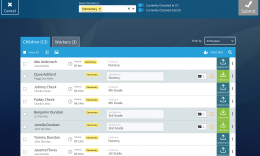Teen Bullying: What to Know and How to Help

October is National Bullying Prevention Month. This is an excellent time to consider how your organization can prevent bullying and help teens experiencing it overcome it. The CDC reports that almost all forms of bullying peak in middle school. Specifically, 6th-grade students reported the highest percentage of bullying at 29%. Unfortunately, 1 in 5 US teens experience a serious mental health condition associated with bullying. Yet only 20% receive the help they need, indicating prevention is critical to reducing the risk in your organization.
Types of Teen Bullying
Bullying happens when a person or group targets someone for not fitting in. Bullies spotlight or make fun of others for how someone looks, acts, their race or religion, social status, or sexual identity.
For teens, bullying presents in different ways, such as:
- Physical bullying. It happens when someone is shoved, tripped, punched, hit, or spit on.
- Verbal bullying. Which includes teasing or taunting someone with disparaging words.
- Psychological bullying. It happens when someone gossips, excludes, or makes someone feel poorly about themselves.
- Cyberbullying is when people use social media or the internet to say hurtful or unkind things, including sending mean texts and posting personal insults, rude comments, private information, pictures, and videos with the intent of hurting or embarrassing another.
The Effects on Teens
According to NCES, youth who are bullied are at risk for depression, anxiety, sleep difficulties, mood disorders, low energy levels and appetite, trouble with schoolwork or learning, and suicidal thoughts or self-harm.
Bullies: Who Are They?
- Bullies can be either male or female.
- Like to be in control of others.
- They are insecure and desperately want to make themselves feel better.
- Narcissistic and only focus on themselves.
- Extroverted and hostile, which means they will make fun of someone to their face or physically hurt them.
- Exhibit a lack of empathy or remorse. Can’t relate to other’s feelings of pain.
- Poor social skills and need help to make friends or get along with others.
- Discreet and tricky because they secretly manipulate others by spreading rumors, gossiping, or saying unkind things behind your back.
- A frenemy who pretends to be friends to get others to open up and share personal information only to use it to harm another’s reputation.
How to Help?
Consider creating and implementing an anti-bullying program that complements your Child Protection Policy. A zero-tolerance stance on bullying will foster an environment that values safety, promotes transparency, prioritizes communication, and empowers youth to respect and support each other.
To help, we have created a three-part series that outlines what to include when designing and implementing an anti-bullying program. Here’s a summary of each part.
Part 1: The Components cover the necessary pieces and parts to create an effective anti-bullying program and help you integrate everyday prevention principles.
Part 2: The Framework discusses defining your program, explaining why you are creating one, and how you intend to accomplish your goals. It also includes which policies, procedures, prevention, and intervention strategies to consider.
Part 3: Implementation offers a ten-step guide to implementing your program and explaining the benefits of tracking performance.
Additional Resources
Here are additional links to learn more about National Bullying Prevention Month, current statistics, and ways to involve your organization:
Click here to learn more about the benefits of using secure children’s and youth check-in to help manage your children’s areas, keep families smiling, and improve safety. You can subscribe to the KidCheck blog or connect with us on X, Facebook, Pinterest, Instagram, and YouTube.
Sources:
https://www.stopbullying.gov/resources/get-help-now
https://www.meganmeierfoundation.org/facts-and-support
Photo by Fernando @cferdophotography on Unsplash (Blog)


